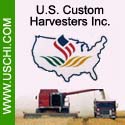 |
 |

|
|
|
Minnesota Ag News Headlines |
 |
Minnesotans Prefer Crop Rotation to Manage Pests in Oats
Minnesota Ag Connection - 05/26/2016
The 2015 Agricultural Chemical Use Survey of oat producers collected data about fertilizer and pesticide use as well as pest management practices in growing oats.
Fertilizer refers to a soil-enriching input that contains one or more plant nutrients, primarily nitrogen (N), phosphate (P2O5), and potash (K2O). Of the three primary macronutrients, nitrogen was the most widely used on oats planted in Minnesota according to
the latest USDA, National Agricultural Statistics Service -- Agricultural Chemical Use report. Farmers applied nitrogen to 60 percent of planted acres at an average rate of 49 pounds per acre per year. Macronutrients phosphate and potash were applied to 50
and 53 percent of the oat acres, at an average rate of 26 and 45 pounds per acre per year, respectively. The secondary macronutrient, sulfur, was applied to 21 percent of acres planted to oats.
The pesticide active ingredients used on oats are classified in this report as herbicides (targeting weeds), insecticides (targeting insects), fungicides (targeting fungal disease) and other chemicals (targeting all other pests and other materials, including extraneous
crop foliage). Herbicide active ingredients were applied to 43 percent of the oat acres planted in Minnesota. 2,4-D, dimethylamine salt was the most widely used pesticide overall, and was the active ingredient with the greatest total amount
Rotating crops during the past 3 years was the top pest management practice for oat acreage in Minnesota.
Other Minnesota Headlines
|
|
 |


|
 |
|
Copyright © 2024 - Farms.com. All Rights Reserved. |
 |
|